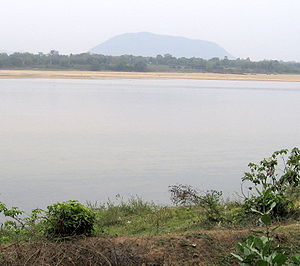Biharinath
Biharinath is the tallest hill of Bankura District, in the Indian state of West Bengal., and one of the dense forest areas of the district. It is a part of the Eastern Ghats. It is 451 metres (1,480 ft) high.[1] It is situated about 60 kilometres (37 mi) north-west of Bankura town and 14 kilometres (9 mi) north-east of Saltora town.
| Biharinath | |
|---|---|
 Biharinath from Nehru Park, Burnpur across the Damodar River | |
| Highest point | |
| Elevation | 451 m (1,480 ft) |
| Coordinates | 23°34′29.65″N 86°55′57.68″E / 23.5749028°N 86.9326889°ECoordinates: 23°34′29.65″N 86°55′57.68″E / 23.5749028°N 86.9326889°E |
| Geography | |
| Location | Saltora, Bankura district, West Bengal, India |
| Parent range | Chota Nagpur Plateau |
GeographyEdit
| Places in Bankura Sadar subdivision in Bankura district M: municipal town/ city, CT: census town, R: rural/ urban centre, H: hill centre, T: temple/ religious centre, B: barrage Owing to space constraints in the small map, the actual locations in a larger map may vary slightly |
LocationEdit
Biharinath is located at 23°34′29.65″N 86°55′57.68″E / 23.5749028°N 86.9326889°E.
Area overviewEdit
The map alongside shows the Bankura Sadar subdivision of Bankura district. Physiographically, this area is part of the Bankura Uplands in the west gradually merging with the Bankura-Bishnupur Rarh Plains in the north-east. The western portions are characterised by undulating terrain with many hills and ridges. The area is having a gradual descent from the Chota Nagpur Plateau. The soil is laterite red and hard beds are covered with scrub jungle and sal wood. Gradually it gives way to just uneven rolling lands but the soil continues to be lateritic. There are coal mines in the northern part, along the Damodar River.[2] It is a predominantly rural area with 89% of the population living in rural areas and only 11% living in the urban areas.[3]
Note: The map alongside presents some of the notable locations in the subdivision. All places marked in the map are linked in the larger full screen map.
Archaeological importanceEdit
With the discovery of Paleolithic tools in the Biharinath area, the hill and the surrounding areas have come into focus of archaeologists.[4]
TourismEdit
Biharinath is known as the Araku Valley of West Bengal.[5] The base of hill is a popular tourist spot. A small tank measuring 0.50 ha provides facilities for angling. There is an old Shiva temple of Biharinath nearby.[6]
Biharinath offers a pollution-free green surroundings where water is panacea. This place has hills, dense forests with abundant flora and fauna, spring, water bodies, Damodar River, and a renowned Shiva temple. Susunia hill, Joychandi Pahar, Garh Panchkot, Baranti, Panchet Dam, and Maithon Dam are all located at short distances. Government of West Bengal has already taken a 150 crore mega tourism project for Biharinath. And with this fund a Cable car operation is likely to be operational by 2016. Also, a bridge over river Damodar has already been sanctioned and then Biharinath will be only a little distance from Burnpur or Asansol but the construction work is yet to be started.
EconomyEdit
The area also has coal deposits. Biharinath block represents south central part of Raniganj Coalfield in Trans Damodar region. The entire area is covered with alluvial soil.[7] People here are mostly dependent on coal mines or visit Asansol/Durgapur area to find a job. After tourism is flourishing at Biharinath people here is getting tourism related job gradually.
ReferencesEdit
- ↑ "Biharinath". West Bengal. india9.com. Retrieved 17 March 2008.
- ↑ "District Census Handbook Bankura" (PDF). pages 13-17. Directorate of Census Operations West Bengal. Retrieved 23 April 2020.
- ↑ "District Statistical Handbook 2013 Darjeeling". Table 2.4b. Department of Statistics and Programme Implementation, Government of West Bengal. Retrieved 23 April 2020.[permanent dead link]
- ↑ "Status of Prehistoric studies in the twenty first century in India" (PDF). C01-13 Progress of Prehistory in Bengal: a cultural overview. UISPP / IUPPS │ XV Congress. Retrieved 13 March 2008.
- ↑ "Biharinath". Weekend Getaways from Kolkata. Retrieved 11 October 2014.
- ↑ "Biharinath". District administration. Archived from the original on 25 September 2012. Retrieved 19 March 2008.
- ↑ "Salient Features". Coal ministry. Archived from the original on 5 December 2007. Retrieved 19 March 2008.